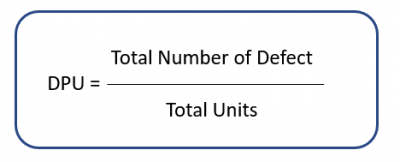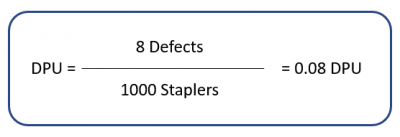
As the new manufacturing engineer for the stapler production line, you find yourself shifting through quality data to get a better understanding regarding the defect rates involved. One of the reasons you were hired was to measure and analyze the failure rates and hunt down the root cause of any yield issues.
Before trying to tackle the problem, you know that understanding the current state of the quality metrics is necessary to prove that your future work improved the situation. That means you need to know the DPU, or defects per unit. Leadership believes there is a quality problem regarding the production line, but do the metrics support that belief?
So, what is the defects per unit of this production line?
An overview: What does defects per unit refer to?
Defects per unit, commonly known as DPU, is a measurement representing the average number of defects that occur with each product unit.
The calculation is the quantity of defects among a group of products divided by the quantity of products in the group.

To use an example, let us take a look at a stapler manufacturer. It produced 100 staplers during a shift. Out of that batch, three had one error, one stapler had two errors, and the final stapler had three errors. The remainder of the staplers were error-free. The total number of errors was eight.
To calculate the DPU, take the eight errors and divide the number by 100 (the total quantity of stapler products) to arrive at a value of 0.08 DPU.

This helps establish the average number of errors that will occur per unit. The lower the number, the fewer the anticipated errors and the better the situation.
3 benefits of attending to defects per unit
Helps you quickly set expectations
DPU is easy to calculate. As long as you are collecting information regarding defects, and know your total production numbers, it takes no time at all to generate the value. Take care in understanding what is considered a defect.
Is easy to understand and allows for simple goal-setting
DPU is a clear metric to use for measuring quality situations, especially at the lower levels. It is often used by quality departments to quantify and justify process improvement efforts.
Accounts for multiple defects per unit of production
Unlike some other quality metrics, DPU accounts for multiple defects per unit of production, thus giving a more complete view of a process.
3 defects per unit best practices
Keep in mind that this measurement does not do a good job of understanding whether multiple different errors are happening to a handful of units, or if there is a singular consistent error happening to a larger subset of units.
Other defect measurements to use in conjunction with defects per unit include defects per opportunity, defects per million opportunities, and parts per million (units defective). Note that the product or service provided is the unit, while customer specifications such as size, shape, material, and timeliness are opportunities.
Be sure to understand what constitutes a defect. In general, a defect is defined as a property of the product or service that does not meet customer specification.
Frequently Asked Questions (FAQ) about defects per unit
Can I use defects per unit as a key performance indicator?
Using defects per unit without considering other quality metrics is not recommended, as DPU by itself does not clearly illustrate the root cause of defects within a system. If you’re looking for a quality-based key performance indicator at a higher level, you might want to utilize RTY, or rolled throughput yield, although this metric has its own limitations in telling the complete story of quality.
How do I select conditions or ranges for my data collection when calculating DPU?
Start with as high of a range as you can when looking for DPU. If this value is not at a desired level, start changing factors, such as production lines, different shifts, times of day within a shift, operators, etc. Trying to see if different factors improve or negatively impact DPU can help you focus in on any root causes for defects.
Do we use defects per unit in a service environment?
The service industry often has different terminology when compared to its manufacturing counterpart, but make no mistake: Services industries still must address errors. Simply replace the “unit” terminology with the service provided, and the measurement will still provide insight to the level of quality the service is providing.
What is a good DPU?
The ideal DPU is zero, as in zero defects, though cost considerations rarely make it financially beneficial to reach a zero level. A good DPU is the lowest value a company can get down to without improvements to the value costing more than the defects’ impact to the company. Continuously strive to lower the number, and watch over time for any increases that might occur.
Defects per unit give a quick, straightforward understanding for likelihood of a defective unit
Defects per unit is a quick and relatively painless metric to calculate and monitor regarding defects. It is a metric that gives a basic understanding of how often we can expect a product to possess a defect. Monitoring different time periods allows for an understanding of whether quality is improving or worsening over time. When used in conjunction with other quality metrics, it can help give a clear picture of the quality of product being produced, or service being provided.